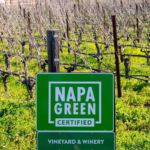
Former President Barack Obama, the keynote speaker at the Porto Protocol, said, “Climate change is the greatest threat to future generations and it should be addressed collectively." Image by Pete Souza
The Wine Exchange: Respecting Science and Community
- ALLEN BALIK | NAPA VALLEY REGISTER |
- August 27, 2020
Vintners, growers and winemakers are tackling climate change and its industry effects on two crucial fronts. One entails the grape’s journey from vine to winery while the other follows its carbon footprint through the transition to wine, a trek to retail shelves and ultimately to our table.
In my last column, I discussed some innovative viticultural practices that are being introduced both experimentally and out of necessity to accommodate to our warmer, drier climate. Some of these included canopy and shade management, altered irrigation regimens, rootstock and clonal trials as well as planting different varieties that are more accustomed to similar climatic conditions in their indigenous homes.
These viticultural remedies are geared to finding ways of “coping” with our new normal but do little to “combat” the underlying causes of the changing climate and creating a healthier environment for the community.
In an effort to broaden the vineyard’s role in combating climate change, an increasing number of growers worldwide are adopting reduced pesticide/fungicide usage along with newer tiling and disking practices and the use of “weed-munching” sheep to minimize carbon release and enhance carbon sequestration in the soils.
These practices are often coupled with increased planting and preserving carbon “sucking” (and oxygen emitting) trees in combination with other foliage around the vineyard as well as grasses and wild flowers between vine rows to absorb and minimize carbon’s escape to the atmosphere.
The battle to reduce the carbon footprint from the winery to our tables involves many complex and connected elements that necessitate cooperation and participation of everyone. To accomplish these goals and realize positive results, several local and international entities have evolved both here and abroad.
On July 6, 2018 in Porto, Portugal, CEO of Taylor’s Port and the Fladgate Partnership Adrian Bridge launched The Porto Protocol. According to Bridge, “Climate change is real and is happening around us every day all over the world… [it] can no longer be ignored. This wine industry initiative is more than just a call to action. It is a binding commitment by its signatories from whatever area, to make a greater contribution to mitigating climate change.”
The Porto Protocol was established as, “A platform where members can share ideas, achievements, solutions and experiences.” An important condition of membership dictates that each winery must also design, initiate and follow a specific program to accomplish an environmentally sensitive goal.
The launch conference included members from around the world and attended by a broad range of sponsors such as technology, manufacturing (including automotive), retail, environmental and many facets of agriculture.
Barack Obama was the keynote speaker and said that, “Climate change is the greatest threat to future generations and it should be addressed collectively.” He acknowledged the overlying concept of The Porto Protocol, “…will raise awareness and the only way to solve the crisis is to work together.”
Locally, growers and vintners have banded together to establish Napa Green Certification in the winery, which is now also evolving to the vineyard. Two closely aligned efforts and programs.
Napa Green Winery said, “Making exceptional wine requires stewardship and attention to detail.” They suggest increasing energy and water efficiency as well as preventing waste through recycling, composting and incorporating environmentally oriented purchasing programs. The overall goal is to reduce the carbon footprint at every step while caring for employees and the community through encouragement and sustainability.
Napa Green Land is an umbrella program focusing on watershed and riparian stewardship, prevention of erosion, conservation measures relating to irrigation and frost protection among other environmentally structured practices.
Similar local/regional programs have also been instituted in the Old World with Bordeaux on the cutting edge. In Decanter’s Bordeaux 2020 supplement, Elin McCoy points out the Interprofessionnel du Vin de Bordeaux (CIVB) is leading the way through their Système de Management Environnemental du Vin de Bordeaux (SME). This effort fosters a collective approach and has already encouraged 65 percent of châteaux to obtain one of many available recognized sustainable certifications.
The U.S. Green Building Council (USGBC) has taken a different approach to the use of “clean energy” that has now grown internationally. USGBC is dedicated to instilling environmentally conscious elements of building through their LEED (Leadership in Energy and Environmental Design) green building rating system.
The LEED program (adopted by many wineries in construction and remodeling) covers all building types through all phases of construction, operations and maintenance. It not only encompasses green building methods and ideology but goes to community benefits as well. “Healthy people in healthy places equals a healthy economy.”
Nicolas Quillé MW is chief winemaking and operations officer for Crimson Wine Group based in Napa, which owns and operates wineries in California, Oregon and Washington. These include Pine Ridge in Napa’s Stags Leap District, Archery Summit in Oregon’s Dundee Hills and Double Canyon in Washington’s Horse Heaven Hills, among several others. Nicolas sees reducing Crimson’s carbon footprint as “A gift that keeps on giving.”
Pine Ridge is a member of both Napa Green and The Porto Protocol. Crimson’s three Washington and Oregon wineries belong to Live, a third-party, non-profit environmental certification and education alliance with roots in the Pacific Northwest and standards now internationally accredited.
The specific Porto Protocol project chosen by Pine Ridge focuses on glass weight. Nicolas sees excess bottle weight in manufacturing, storage and shipping as “The biggest contributor to the wine industry’s greenhouse gas production as it represents one-third of its carbon footprint.”
Working on this project in the last 12 months, Crimson Wine Group has redirected 98 percent of its bottle sourcing from China to the U.S. and reduced glass weight by 13 percent (300 tons of glass) company-wide. This represents a big stride toward their goal of carbon neutrality. Nicolas says, “…our ultimate objective is to become carbon neutral. While we’re not sure how long that will take, we are determined to get there.”
Chuck McMinn is co-proprietor with his wife Anne of Vineyard 29 in St. Helena where he was an early proponent of clean energy and reducing his winery’s carbon footprint. They are also members of The Porto Protocol and Napa Green. Chuck feels strongly, “As farmers, it is important for us to respect the land and climate that is our livelihood…[We must] continually ask ourselves how we can act as a business to minimize climate change and prioritize the environment.”
Chuck’s extensive high-tech background led him to the early installation of sophisticated principles in the vineyard, winery and water usage/outputs. In the vineyard, Chuck’s team has characterized all sites and blocks using water sap flow sensors to determine exact water needs that are continually monitored to minimize water usage.
In the winery, Vineyard 29 has installed two Capstone Micro Turbines to recapture heat with each producing 60 kilowatts, providing all needed power. The system operates at a 75 percent efficiency rate by recirculating heat from the turbines compared to PG&E’s 33 percent efficiency without adequate heat waste capture. Through a complex web of micro turbines, a spinning generator and all connecting loops, Vineyard 29 is also able to capture heat to operate the heating, venting and air conditioning, satisfy hot water needs and support the glycol temperature control in fermentation tanks.
All of Vineyard 29’s water needs are supplied from on-site wells and discharge is sent to onsite leach fields. They are currently preparing a Use Permit Modification that will involve the installation of a Biofiltro Biodynamic Aerobic (BIDA®) system that uses worms to digest and purify wastewater for immediate reuse on site. Chuck is considering this system for his Porto Protocol project going forward.
In his opening remarks at the launch conference of The Porto Protocol just two years ago, Adrian Bridge firmly said, “As our speakers today will confirm, evidence of climate change is clear and incontrovertible. Its effect on human lives and livelihoods can no longer be ignored.” Thankfully, the international wine community, along with many of its leaders, innovators and suppliers is stepping up to the plate regardless of cost to implement this objective.
Making the commitment to third party certification takes time and effort, but it is worth it to demonstrate our commitment to the community and to protect our watershed, our land and the air we breathe.
- Susan Boswell, Chateau Boswell Winery


